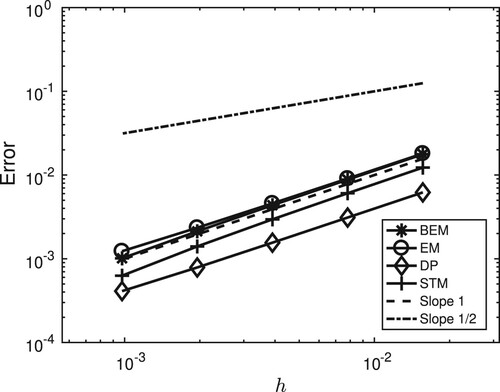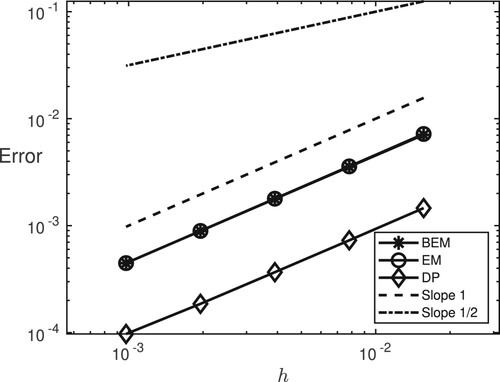Figures & data
Figure 1. Linear stochastic oscillator: numerical trace formulas for on the interval
(left) and
(right). Comparison of the Euler–Maruyama scheme (EM), the stochastic trigonometric method (STM), the drift-preserving scheme (DP), the backward Euler–Maruyama scheme (BEM), and the exact solution.
![Figure 1. Linear stochastic oscillator: numerical trace formulas for E[H(p(t),q(t))] on the interval [0,5] (left) and [0,100] (right). Comparison of the Euler–Maruyama scheme (EM), the stochastic trigonometric method (STM), the drift-preserving scheme (DP), the backward Euler–Maruyama scheme (BEM), and the exact solution.](/cms/asset/9b5b80c3-5431-47be-8bc5-cbee34d0aca5/gcom_a_1922679_f0001_ob.jpg)
Figure 2. Linear stochastic oscillator: mean-square convergence rates for the backward Euler–Maruyama scheme (BEM), the Euler–Maruyama scheme (EM), the drift-preserving scheme (DP), and the stochastic trigonometric method (STM). Reference lines of slopes 1, resp. 1/2.

Figure 3. Linear stochastic oscillator: weak convergence rates for the backward Euler–Maruyama scheme (BEM), the Euler–Maruyama scheme (EM), the drift-preserving scheme (DP), and the stochastic trigonometric method (STM). Reference lines of slopes 1, resp. 2. (a) Errors in the first moments (left) and
(right), (b) Errors in the second moments
(left) and
(right).
![Figure 3. Linear stochastic oscillator: weak convergence rates for the backward Euler–Maruyama scheme (BEM), the Euler–Maruyama scheme (EM), the drift-preserving scheme (DP), and the stochastic trigonometric method (STM). Reference lines of slopes 1, resp. 2. (a) Errors in the first moments E[q(t)] (left) and E[p(t)] (right), (b) Errors in the second moments E[q(t)2] (left) and E[p(t)2] (right).](/cms/asset/9db439d1-af60-400d-bfd5-c6de312e9a91/gcom_a_1922679_f0003_ob.jpg)
Figure 4. Linear stochastic oscillator: numerical trace formulas for on the interval
. Comparison of the drift-preserving scheme (DP), the splitting methods with, respectively, the symplectic Euler method (SYMP), the Störmer-Verlet method (ST), the explicit Euler method (splitEULER), the Heun method (splitHEUN), and the exact solution.
![Figure 4. Linear stochastic oscillator: numerical trace formulas for E[H(p(t),q(t))] on the interval [0,100]. Comparison of the drift-preserving scheme (DP), the splitting methods with, respectively, the symplectic Euler method (SYMP), the Störmer-Verlet method (ST), the explicit Euler method (splitEULER), the Heun method (splitHEUN), and the exact solution.](/cms/asset/fc85b82f-4ed9-4909-a34d-f38817a7add2/gcom_a_1922679_f0004_ob.jpg)
Figure 5. Stochastic mathematical pendulum: numerical trace formulas for on the interval
. Comparison of the drift-preserving scheme (DP), the splitting methods with, respectively, the symplectic Euler method (SYMP), the Störmer-Verlet method (ST), the explicit Euler method (splitEULER), and the exact solution.
![Figure 5. Stochastic mathematical pendulum: numerical trace formulas for E[H(p(t),q(t))] on the interval [0,100]. Comparison of the drift-preserving scheme (DP), the splitting methods with, respectively, the symplectic Euler method (SYMP), the Störmer-Verlet method (ST), the explicit Euler method (splitEULER), and the exact solution.](/cms/asset/cf655c75-936d-454e-8584-d94e00a2b3db/gcom_a_1922679_f0005_ob.jpg)
Figure 6. Stochastic rigid body problem: numerical trace formulas for the energy (left) and for the Casimir
(right) for the drift-preserving scheme (DP), the Euler–Maruyama scheme (EM), the backward Euler–Maruyama scheme (BEM), and the exact solution.
![Figure 6. Stochastic rigid body problem: numerical trace formulas for the energy E[H(X(t))] (left) and for the Casimir E[C(X(t))] (right) for the drift-preserving scheme (DP), the Euler–Maruyama scheme (EM), the backward Euler–Maruyama scheme (BEM), and the exact solution.](/cms/asset/8a434c59-4aa0-40a2-b469-ca3e684535ec/gcom_a_1922679_f0006_ob.jpg)
Figure 7. Stochastic rigid body problem: mean-square convergence rates for the backward Euler–Maruyama scheme (BEM), the drift-preserving scheme (DP), and the Euler–Maruyama scheme (EM). Reference lines of slopes 1, resp. 1/2.

Figure 8. Stochastic rigid body problem: weak convergence rates in the first moment (left) and second moment
(right) for the drift-preserving scheme (DP), the Euler–Maruyama scheme (EM), and the backward Euler–Maruyama scheme (BEM). Reference lines of slopes 1, resp. 2.
![Figure 8. Stochastic rigid body problem: weak convergence rates in the first moment E[X1(tn)] (left) and second moment E[X1(tn)2] (right) for the drift-preserving scheme (DP), the Euler–Maruyama scheme (EM), and the backward Euler–Maruyama scheme (BEM). Reference lines of slopes 1, resp. 2.](/cms/asset/f7ada197-64ec-4f88-9e42-4cf6460a5632/gcom_a_1922679_f0008_ob.jpg)
Figure 9. Stochastic rigid body problem with two-dimensional noise: numerical trace formulas for the energy (left) and for the Casimir
(right) for the Casimir
(right) for the drift-preserving scheme (DP), the Euler–Maruyama scheme (EM), the backward Euler–Maruyama scheme (BEM), and the exact solution.
![Figure 9. Stochastic rigid body problem with two-dimensional noise: numerical trace formulas for the energy E[H(X(t))] (left) and for the Casimir E[C(X(t))] (right) for the Casimir E[C(X(t))] (right) for the drift-preserving scheme (DP), the Euler–Maruyama scheme (EM), the backward Euler–Maruyama scheme (BEM), and the exact solution.](/cms/asset/96e33fd3-8ebf-4ac4-8b40-4698deb6e194/gcom_a_1922679_f0009_ob.jpg)
